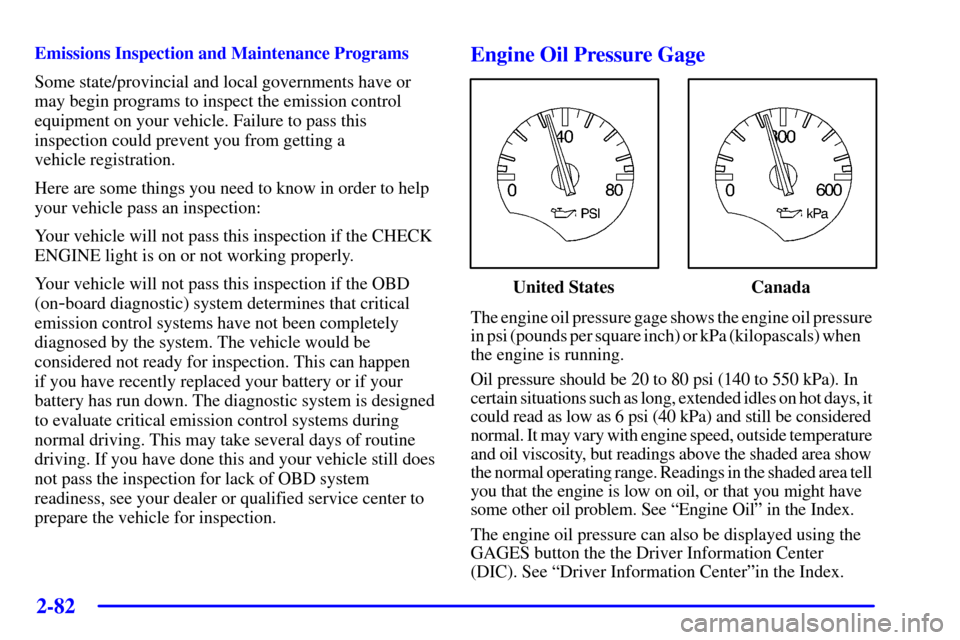Page 18 of 361
Tire Pressure
See Section 6
Service Station Guide
Oil Viscosity
Engine Oil
See Section 6
Engine Oil Dipstick
See Section 6
Premium Fuel Recommended
Use unleaded gas only,
91 Octane or higher.
See Section 6
Cooling System
See Section 5
Windshield Washer
Fluid
See Section 6
Alternate
Fuel Door Release
See Section 6
Battery
See Section 6
Remote Fuel
Release Door
See Section 6
For
a More
Detailed Look at
What's Under the Hood
See Section 6
Hood Release
See Section 6
Page 140 of 361

2-82
Emissions Inspection and Maintenance Programs
Some state/provincial and local governments have or
may begin programs to inspect the emission control
equipment on your vehicle. Failure to pass this
inspection could prevent you from getting a
vehicle registration.
Here are some things you need to know in order to help
your vehicle pass an inspection:
Your vehicle will not pass this inspection if the CHECK
ENGINE light is on or not working properly.
Your vehicle will not pass this inspection if the OBD
(on
-board diagnostic) system determines that critical
emission control systems have not been completely
diagnosed by the system. The vehicle would be
considered not ready for inspection. This can happen
if you have recently replaced your battery or if your
battery has run down. The diagnostic system is designed
to evaluate critical emission control systems during
normal driving. This may take several days of routine
driving. If you have done this and your vehicle still does
not pass the inspection for lack of OBD system
readiness, see your dealer or qualified service center to
prepare the vehicle for inspection.
Engine Oil Pressure Gage
United States Canada
The engine oil pressure gage shows the engine oil pressure
in psi (pounds per square inch) or kPa (kilopascals) when
the engine is running.
Oil pressure should be 20 to 80 psi (140 to 550 kPa). In
certain situations such as long, extended idles on hot days, it
could read as low as 6 psi (40 kPa) and still be considered
normal. It may vary with engine speed, outside temperature
and oil viscosity, but readings above the shaded area show
the normal operating range. Readings in the shaded area tell
you that the engine is low on oil, or that you might have
some other oil problem. See ªEngine Oilº in the Index.
The engine oil pressure can also be displayed using the
GAGES button the the Driver Information Center
(DIC). See ªDriver Information Centerºin the Index.
Page 264 of 361

6-15
�SAE 5W-30
As shown in the viscosity chart, SAE 5W
-30 is best
for your vehicle. However, you can use SAE
10W
-30 if it's going to be 0�F (-18�C) or above.
These numbers on an oil container show its viscosity,
or thickness. Do not use other viscosity oils such
as SAE 20W
-50.
Oils meeting these
requirements should also
have the starburst symbol
on the container. This
symbol indicates that the oil
has been certified by the
American Petroleum
Institute (API).You should look for this on the oil container, and
use only those oils that are identified as meeting GM
Standard 4718M and have the starburst symbol on the
front of the oil container.
Your vehicle's engine is filled at the factory with a
Mobil 1
� synthetic oil, which meets all requirements
for your vehicle.
Substitute Engine Oil: When adding oil to maintain
engine oil level, oil meeting GM Standard GM4718M
may not be available. You can add substitute oil
designated SAE 5W
-30 with the starburst symbol at all
temperatures. If temperatures are above 0�F (
-18�C),
you may substitute SAE 10W
-30 with the starburst
symbol. Substitute oil not meeting GM Standard
GM4718M should not be used for an oil change.
Engine Oil Additives
Don't add anything to your oil. The recommended oils
with the starburst symbol are all you will need for good
performance and engine protection.
Page 344 of 361

7-19
Part D: Recommended Fluids
and Lubricants
NOTE: Fluids and lubricants identified below by name,
part number or specification may be obtained from
your dealer.
USAGE
FLUID/LUBRICANT
Engine OilThe engine requires a special
Engine Oil meeting GM Standard
GM4718M. Oils meeting this
Standard may be identified as
synthetic, and should also be
identified with the American
Petroleum Institute Certified
For Gasoline Engines starburst
symbol. However, not all
Synthetic API oils with the
Starburst symbol will meet this
GM Standard. You should look
for and use only an oil that meets
GM Standard GM4718M. For the
proper viscosity, see ªEngine Oilº
in the Index.
USAGEFLUID/LUBRICANT
Engine Coolant50/50 mixture of clean, drinkable
water and use only GM
Goodwrench
� DEX-COOL�
or Havoline� DEX-COOL�
Coolant. See ªEngine Coolantº
in the Index.
Hydraulic
Brake SystemDelco Supreme 11� Brake Fluid
(GM Part No. 12377967 or
equivalent DOT
-3 Brake Fluid).
Windshield
Washer SolventGM Optikleen� Washer Solvent
(GM Part No. 1051515)
or equivalent.
Hydraulic
Clutch SystemHydraulic Clutch Fluid (GM
Part No. 12345347 or equivalent
DOT
-3 Brake Fluid).
Power
Steering SystemGM Power Steering Fluid
(GM Part No. 1052884
- 1 pint,
1050017
- 1 quart, or equivalent).
Manual
TransmissionDEXRON�-III Automatic
Transmission Fluid.